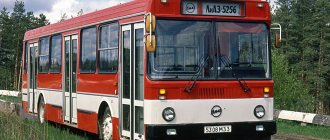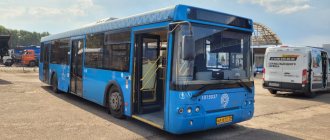New semi-low-floor LiAZ - from the passenger’s point of view
A little less than a year ago, we talked about the start of production of new LiAZ-5292 buses in a semi-low-floor suburban version for the Mostransavto carrier from the Moscow region. In mid-June of this year, transport workers reported that the delivery had been completed, and new buses began to appear on the streets of populated areas in the Moscow region. They also went on routes in the city of Korolev, where I live. And I didn’t miss the chance to be one of the first to ride the new LiAZ.
In profile, the new bus looks unusual due to its long rear overhang without a door.
Buses for the Moscow region, which received their own additional index 5292.65-03, became part of the leasing contract between the Ministry of Transport and Infrastructure of the region and the Sberbank Leasing organization. In addition to 632 of these LiAZs, it included another 29 training buses, as well as 27 all-wheel drive towing vehicles (apparently we are talking about the Urals Next, which we wrote about) and five heavy tow trucks (meaning KAMAZ trucks with an 8x4 wheel arrangement - we also talked about them ). Based on the open information presented on the government procurement website, each semi-low-floor LiAZ is valued at 12 million rubles, and the amount of the entire contract is 9,374,062,000 rubles.
On the left is the new semi-low floor, on the right is the urban low floor. Their front masks are the same
Externally, the new LiAZ is maximally unified with the restyled model 5292 - the front and rear masks are similar, and the dimensions are the same. However, if you look from the side, everything falls into place. Due to the fact that there are two doors (single-leaf front and wide double-leaf central), the back of the bus seems unusually elongated. Also noteworthy is the absence of a grille at the rear of the left side: the YaMZ-536 engine produces 276 hp. placed here not like a low-floor one in a separate shaft on the left, but more traditionally - in the overhang. It is paired with a ZF six-speed automatic transmission. The rear axle here is not portal, but the most common one - Raba brand.
The engine moved to its traditional location in the rear overhang
It is interesting that, although these buses are formally considered suburban, in Korolev they also run regular intracity routes. And so far there are not many of them: in order to wait for a newcomer, I had to skip a couple of ordinary low-floor ones.
There are many steps, but they are all low
I enter through the single-leaf front door (the central hinged door works exclusively for exit) and find myself in an unusual salon. It is light and spacious here, like in a city bus, but instead of simple seats there are soft chairs with high backs, three-point seat belts, folding tables and nets for small items. On such a “throne” you can easily survive a long trip, but its resistance to vandalism is obviously lower than that of purely urban hard seats. There are a total of 42 seats in the cabin, and the total passenger capacity is 93 people.
First of all, I went to the gallery - several low steps lead there. It's comfortable to sit - your legs aren't cramped, and the roof doesn't put pressure on you. Vibrations and noise from the engine are felt, but no more than in a similar urban LiAZ. But the ride of the new bus is still rougher - this is especially noticeable when passing speed bumps, of which there are plenty on the city roads. But when driving over bumps, the upholstery is still silent - again, in older low-floor vehicles it already rumbles.
But I can’t say absolutely anything about the operation of the air conditioning system: on the day of my trips it was hot outside, but the drivers of both new buses that I managed to ride on simply did not turn on the air conditioning. Ventilation was carried out exclusively through open vents, and the interiors were downright stuffy.
Having observed the passengers, I can note that the semi-low-floor layout of the cabin organizes them well. Those who have a short distance to travel do not climb up - they either sit in the front part of the cabin, or even stand on a wide storage area in the center. However, I didn’t go during rush hour, so I can’t predict what will happen when the cabin is filled to capacity.
As for my general passenger impressions of the new bus, they are rather positive: the car turned out to be neat and versatile. Albeit with reservations, but such a LiAZ can also work on city routes. However, the most optimal place for its use is quiet country roads. There are still enough of these in our region.
History of creation
Until 1958, the ZIL-158 bus was actively involved in passenger transportation. However, on the specified date, it was decided to transfer this vehicle from the plant to them. Likhachev, located in Moscow, to the Likinsky Machine-Building Plant, specializing in the production of parts for trucks, which was then named LiAZ. This was due to the fact that the car model was outdated and no longer met the needs of the population at that time.
The fact is that the ZIL-158 could carry only 60 passengers. Since full-scale construction of residential high-rise buildings in cities was underway at that time, a more spacious vehicle was required. As a result, they decided to write off the ZIL and begin production of a bus with a large interior.
The first Soviet bus LiAZ appeared on the roads in 1959. From this time until 1970, more than 62,000 vehicles of this brand were produced. The car was discontinued in 1994.
The engine was located in front of the vehicle on the right hand of the driver. This placement was not chosen by chance. Since the engine was located in the cab, this allowed the driver to troubleshoot the problem without leaving the car. This was done for residents of the northern regions of Russia, so that specialists could carry out repairs in the vehicle itself. The driver and engine seats were connected into a common space. A partition separated this part of the car from the bus passengers.
The location of the engine in front of the car made it possible to free up the rear area to accommodate more passengers, for citizens with strollers and bicycles.
To increase passenger turnover and reduce idle time at stops, the bus was equipped with double doors. This allowed citizens to leave the vehicle on one side of the door, and to enter the vehicle on the other.
The LiAZ 677 received a more comfortable interior compared to its predecessor ZIL-158. The designers have reduced the number of “seated” seats for passengers. This made movement around the cabin more comfortable and increased the total number of passengers.
General technical specifications
The LiAZ-5256 bus body has a long service life (up to 12 years). At the plant where the model is produced, 4 cataphoresis baths were designed in which the galvanizing process takes place. The body is completely immersed in an electrolyte solution, making the frame structure strong and reliable.
Dimensions of the LiAZ-5256 city bus:
LiAZ-5256 - dimensions
- length - 11400 mm;
- width - 2500 mm;
- height - 3007 mm.
Most of the parts are made on machines using plasma cutting or lasers. The side panels undergo a cataphoresis procedure, which reliably protects them from corrosion. The LiAZ-5256 bus is painted manually due to its large dimensions.
Advantages and disadvantages of the bus
The LiAZ 677 bus has the following advantages:
- a spacious interior that allowed for the transportation of a large number of passengers;
- spacious doors to increase passenger turnover and reduce idle time at stops;
- spacious rear deck;
- air suspension without vertical oscillations and smooth start and braking - this protected passengers from motion sickness.
After some time, passengers began to discover the shortcomings of the bus. First of all, citizens felt an unpleasant odor that spread throughout the cabin. The aroma appeared due to the unusual design of the heating system. The engine of the car, like any other vehicle, is equipped with a cooling radiator to prevent the mechanism from overheating. In the LiAZ 677 model, a fan was placed in front of the radiator to blow air. Next, the flow went into a rectangular box, which was located at floor level on the left side of the cabin. From here the air flowed to the passengers through the cracks. As a result, an unpleasant smell of spent fuel appeared.
Passengers could feel this aroma even in summer. This is due to the fact that there was a damper behind the radiator, which was supposed to block the air flow into the cabin. However, due to its inconvenient location, not all drivers closed it for the summer. As a result, the unpleasant smell “stood” in the bus all year round. Because of this, passengers stopped paying attention to the comfort of the cabin and the width of the doors, and only discussed the aroma, which was sometimes impossible to tolerate, especially in the heat. This covered all the advantages of the vehicle.
Photo of the bus interior
In addition, if drivers were too lazy to close the damper in the summer, the heat in the cabin was unbearable, which created a negative impression of the bus. On the other hand, in the autumn-winter period the bus was warm, so passengers could warm up in the car even in extreme cold.
The next drawback of the bus is problems with the engine. In the summer months the engine overheated, and in the winter it overcooled. To avoid such a situation, drivers were forced to keep the engine cover open, and in winter fix additional heat-insulating materials on top.
Detailed story about the LiAZ 677 bus in the video.
The LiAZ 677 bus is one of the best vehicles of its time. Despite the fact that it has long been discontinued, many remember it fondly, despite its many shortcomings. The vehicle can still be seen “live”. A miniature kit model 1 43 was released for DIY construction, which is especially prized by collectors.
Review of the LiAZ 5256 bus.
Views: 9,026
Volume of fuel consumed
Fuel tank LiAZ-5256
The bus fuel system can be designed for diesel or gas fuel. In the first case, it is in tanks with a volume of 238 liters, in the second - in containers of 776 liters. Average fuel consumption per 100 km is 28-32 liters. The car can reach a maximum speed of 120 km/h, and in modifications for transporting children there is a limit of no more than 40 km/h.
Braking system - with pneumatic drive ABS. The brakes are standard for all LiAZ vehicles, with a wedge clamp. The steering system is equipped with a hydraulic booster. New models are available with both manual and automatic transmissions.









